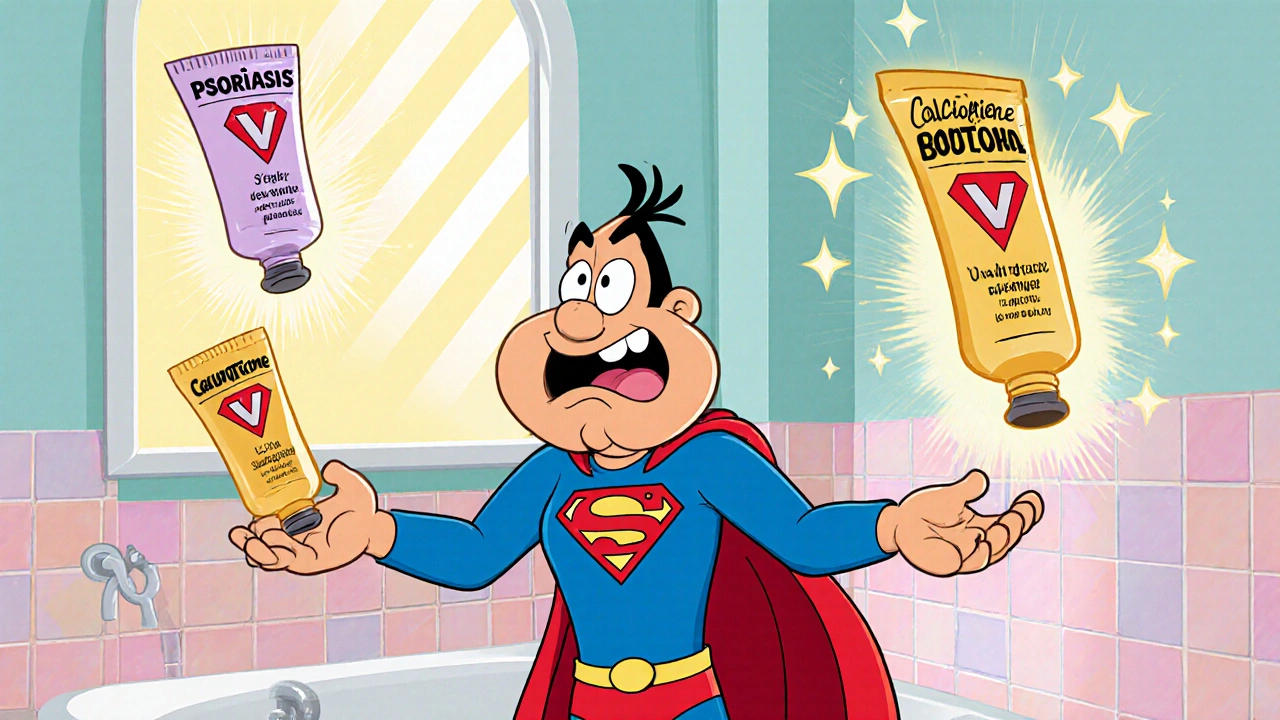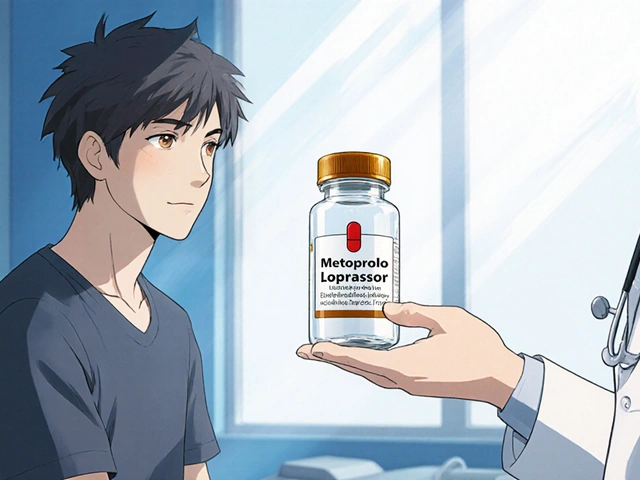Calcipotriene Dosage Calculator
Calculate Your Treatment Amount
This tool helps you determine the proper amount of calcipotriene cream to apply based on your psoriasis plaques. Always follow your dermatologist's advice.
Recommended Application
Each application should be about the size of a pea (approximately 0.05ml).
According to the article, apply a thin layer about the size of a pea to each plaque. Using more than needed may increase risk of side effects like irritation.
Living with psoriasis can feel like you’re constantly juggling creams, appointments, and a lot of uncertainty. One medication that’s quietly reshaping that experience is calcipotriene. It’s not just another lotion on the shelf - it’s a vitamin D‑based therapy that helps many patients reclaim smoother skin and a calmer mind.
What is Calcipotriene?
Calcipotriene is a synthetic analogue of vitamin D3, specifically designed for topical use on the skin. Its chemical name is calcipotriene cream, and it works by slowing down the rapid growth of skin cells that characterises psoriasis. First approved by the FDA in 1997, it’s been a staple in the UK’s NHS formulary for over two decades.
How Does Calcipotriene Work?
Psoriasis flares when the immune system sends mixed signals that speed up keratinocyte production. Calcipotriene binds to vitamin D receptors in skin cells, nudging them back into a normal growth cycle. Think of it as a traffic light that tells the cells to slow down and stop piling up. This reduces the thick, scaly patches that many patients find so embarrassing.
Using Calcipotriene Safely
Even though it’s a cream, there are some best‑practice steps to get the most out of it:
- Wash the affected area with gentle soap and pat dry.
- Apply a thin layer (about the size of a pea) to each plaque.
- Let it absorb for 5-10 minutes before covering with clothing.
- Use once daily unless your dermatologist advises otherwise.
Most guidelines recommend a 2‑ to 4‑week trial, after which you assess improvement. If you notice excessive redness or irritation, cut back to every other day or pause for a few days.
Benefits for Patients
Why are patients calling it empowering? Here are a few real‑world wins:
- Visible improvement: Clinical trials show a 60‑70% reduction in plaque thickness after 12 weeks.
- Minimal systemic absorption, meaning lower risk of affecting calcium levels.
- Can be combined with other treatments like topical steroids for a synergistic effect.
- Often covered by the NHS, reducing out‑of‑pocket cost.
Emma, a 34‑year‑old from Bristol, shared that after three months of consistent use, she could finally wear sleeveless tops without feeling self‑conscious. Stories like hers illustrate the confidence boost that comes with clearer skin.

Calcipotriene in the Bigger Psoriasis Management Picture
Psoriasis is a chronic inflammatory disease that affects roughly 2% of the UK population. Managing it usually involves a layered approach, and calcipotriene fits neatly into the “topical” tier.
Other common layers include:
- Topical corticosteroids - fast‑acting, but long‑term use can thin skin. \n
- Vitamin D analogues (like calcipotriene) - slower onset but safer for prolonged use.
- Phototherapy - UV light treatment for moderate cases.
- Systemic drugs such as Methotrexate or biologics like Adalimumab - reserved for severe disease.
Choosing the right mix depends on plaque severity, location, and personal lifestyle. Calcipotriene often serves as the first‑line therapy for mild‑to‑moderate plaque psoriasis because it balances efficacy with safety.
Practical Tips to Maximise Results
Here are some clinician‑approved tricks:
- Stay consistent: Skipping days reduces the cumulative effect.
- Combine wisely: Adding a low‑potency steroid a few nights a week can jump‑start improvement.
- Moisturise after absorption: A fragrance‑free moisturizer seals in the medication and keeps skin barrier healthy.
- Monitor calcium: Rarely, high‑dose use can raise serum calcium - a simple blood test can catch it early.
- Follow up: Schedule a review with your dermatologist after 4 weeks to decide on continuation.
Common Concerns & Side Effects
Most users tolerate calcipotriene well, but a few issues can arise:
- Local irritation: Redness, itching, or a mild burning sensation.
- Hypercalcemia: Extremely rare, usually linked to excessive use over large body areas.
- Allergic reaction: Uncommon, but if you see swelling or hives, stop and seek medical advice.
Addressing these concerns early can prevent abandonment of an otherwise effective therapy.

Calcipotriene vs. Other Topical Options
| Aspect | Calcipotriene | Topical Corticosteroid (e.g., Clobetasol) | Tazarotene (Retinoid) |
|---|---|---|---|
| Mechanism | Vitamin D receptor agonist | Anti‑inflammatory, immunosuppressive | Modulates skin cell growth via retinoic acid receptors |
| Onset of Action | 4-6 weeks | 1-2 weeks | 2-4 weeks |
| Side‑Effect Profile | Local irritation, rare hypercalcemia | Skin thinning, telangiectasia | Dryness, irritation, photosensitivity |
| Long‑Term Use | Generally safe for extended use | Limited to intermittent use | May require breaks to avoid irritation |
| Cost (UK NHS) | Often reimbursed | Often reimbursed | Usually not covered |
In a nutshell, calcipotriene offers a slower but steadier route to clear skin, with a safety margin that makes it ideal for long‑term maintenance.
When to Seek Professional Guidance
If you notice any of the following, book a dermatologist appointment:
- Plaques that haven’t improved after 8-12 weeks.
- Widespread redness or swelling beyond the treated area.
- Signs of high calcium levels (muscle weakness, frequent urination).
A timely check can adjust your regimen before problems become entrenched.
FAQs
Frequently Asked Questions
Can I use calcipotriene on my face?
Yes, but use a very thin layer and monitor for irritation. Many dermatologists reserve it for body plaques and prescribe a milder steroid for facial lesions.
Is calcipotriene safe for pregnant women?
The data are limited, so most clinicians advise avoiding it during pregnancy unless the benefit clearly outweighs potential risk.
How long does a typical treatment course last?
Initial trials run 8‑12 weeks. If you respond well, many patients continue long‑term, applying it to flare‑prone spots as needed.
Can I combine calcipotriene with phototherapy?
Yes, combination therapy is common. The two treatments act on different pathways, often delivering faster clearance.
What should I do if I forget a dose?
Just apply it when you remember. Don’t double‑dose the next day; the medication’s effects are cumulative, not immediate.
Armed with the right knowledge, you can turn calcipotriene from a prescription label into a confidence‑boosting part of your daily routine.








Yassin Hammachi October 16, 2025
Living with psoriasis often feels like walking a tightrope between frustration and hope. Calcipotriene offers a subtle shift, nudging the skin's own rhythm back into balance. When a patient sees those stubborn plaques soften, it’s more than a cosmetic win-it’s a reminder that agency still exists in chronic illness. Think of the cream as a small lever that, over weeks, can move a larger weight of confidence. The real empowerment comes from the consistency and the quiet trust in a therapy that respects the body’s own pathways.
Michael Wall October 18, 2025
If you’re not following the guidelines, you’re basically gambling with your skin and potentially your calcium levels. The NHS covers it for a reason – it’s been vetted for safety when used as directed. Skipping the recommended wash‑dry‑apply routine just invites irritation and defeats the purpose. Don’t assume “more is better”; the product isn’t a miracle cure, it’s a measured tool. Keep it simple and stick to the plan.
Christopher Xompero October 20, 2025
This cream is a total game‑changer, no cap!
Irene Harty October 21, 2025
One must consider the opaque mechanisms by which pharmaceutical entities disseminate ostensibly benign agents, such as calcipotriene, whilst subtly steering clinical practice toward dependence. The paucity of transparent long‑term data engenders a reasonable degree of scepticism. It would be imprudent to accept the narrative of empowerment without scrutinising the underlying commercial incentives. Moreover, the occasional reports of hypercalcaemia, albeit rare, suggest that the safety profile is not immaculate. Therefore, clinicians and patients alike should maintain a vigilant stance.
Jason Lancer October 23, 2025
Honestly, I tried the cream once and it was just okay. The texture felt greasy and the instructions seemed over‑complicated for a simple lotion. I didn’t notice any dramatic change after a month, so I moved on to something else. I guess it works for some, but it wasn’t a game‑changer for me.
Brooks Gregoria October 25, 2025
Let’s cut the hype: calcipotrene is just another marketing ploy dressed up as “empowerment”. Sure, it slows cell turnover, but you’re paying for a snail‑pace result while ignoring stronger alternatives. If you truly want control, you should be demanding systemic options sooner rather than tolerating a weak topical. The industry loves to glorify slow‑acting creams because they can pump out prescriptions without real accountability. Stop buying the fairy‑tale and ask for real solutions.
Sumit(Sirin) Vadaviya October 27, 2025
Yassin, you’ve captured the essence beautifully-consistency truly is the hidden hero in dermatology. I’ve seen patients who stuck to the regimen and gradually regained confidence in their everyday attire. The subtle, steady progression often feels more sustainable than a quick fix. 😊 It’s a reminder that small daily actions can culminate in significant change.
lindsey tran October 28, 2025
Michael, omg you’re so right, “simple” is the way to go! I’ve watched friends get all freaked out when they deviate from the routine, and honestly it’s heartbreaking. Y'know, sticking to the basics isn’t boring-it’s the secret sauce that keeps the flare-ups at bay. Keep shouting that message, it’s needed!
Krishna Sirdar October 30, 2025
Irene, I hear your concerns and they’re valid. It’s easy to feel uneasy when information is scarce, but many patients find calm by discussing these worries with their dermatologist. Transparency and regular blood checks can ease the fear of hidden side effects. You’re not alone in navigating this, and sharing experiences helps everyone feel safer.
becca skyy November 1, 2025
Calcipotriene might sound like just another cream, but when you break down the science and the real‑world experiences, it becomes a surprisingly versatile tool in the psoriasis toolkit. First, its vitamin D analogue action means it works at the cellular level, gently coaxing keratinocytes to slow down their overproduction without the harsh side‑effects of steroids. Second, because it’s topically applied, systemic absorption is minimal, which translates to a lower risk of affecting calcium metabolism for most users. Third, the cost factor is a big win in the UK where the NHS often covers it, making it accessible for many who might otherwise skip treatment due to price. Fourth, the flexibility of combining it with low‑potency steroids or phototherapy opens up a personalized treatment plan that can adapt as the disease evolves. Fifth, patient stories-like the young professional who finally felt comfortable showing her arms at a beach party-highlight the confidence boost that goes beyond skin health. Sixth, the gradual onset (usually 4–6 weeks) teaches patience, which can be a valuable lesson in chronic disease management. Seventh, regular follow‑ups allow dermatologists to tweak the regimen, whether that means adjusting frequency or adding moisturizers to lock in moisture. Eighth, the mild irritation some people experience is usually manageable with a fragrance‑free moisturizer, and it often diminishes as the skin acclimates. Ninth, for those wary of long‑term steroid use, calcipotriene provides a safer maintenance option that can keep flare‑ups at bay without thinning the skin. Tenth, it’s worth noting that the medication can be used on various body parts, though the face requires an especially thin layer and close monitoring. Eleventh, the rare cases of hypercalcemia serve as a reminder that even “topical” treatments deserve proper oversight. Twelfth, many clinicians recommend a short trial of 8–12 weeks to gauge response before committing to longer use, which aligns with evidence‑based practice. Thirteenth, the psychological impact-reducing the social anxiety tied to visible plaques-can improve overall quality of life. Fourteenth, education about proper application (clean skin, thin pea‑sized amounts, waiting before dressing) maximizes efficacy. Fifteenth, staying informed about new combination therapies keeps patients at the forefront of emerging best practices. Finally, embracing calcipotriene as part of a broader, holistic approach-diet, stress management, and regular exercise-creates the most robust defense against stubborn psoriasis.